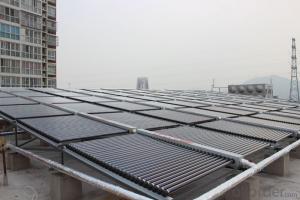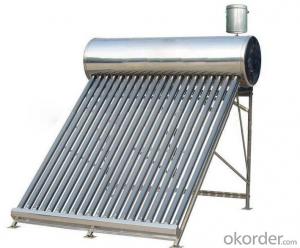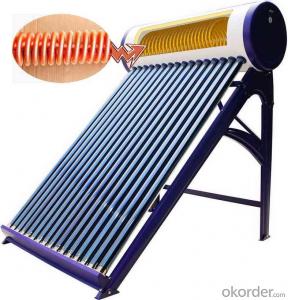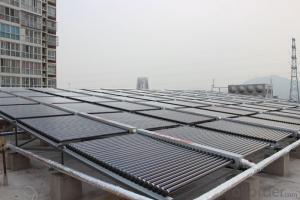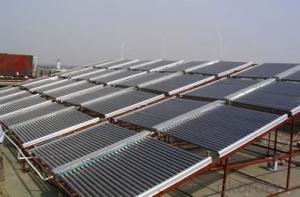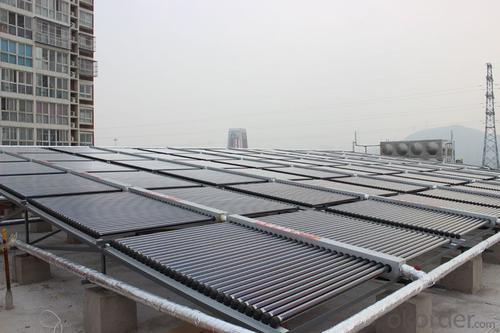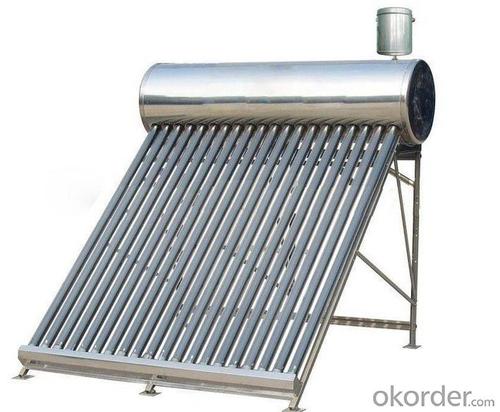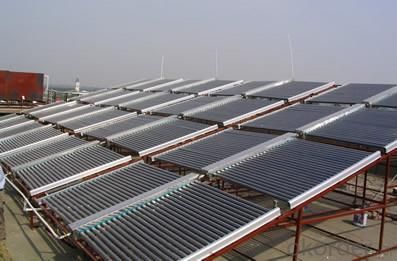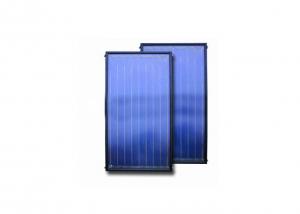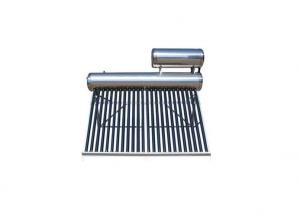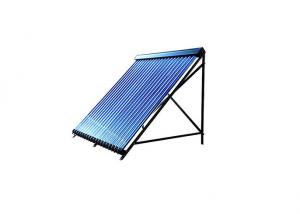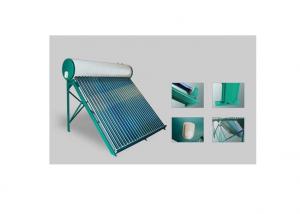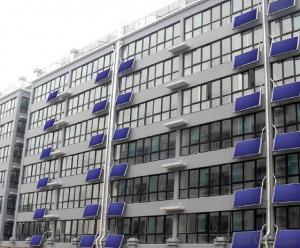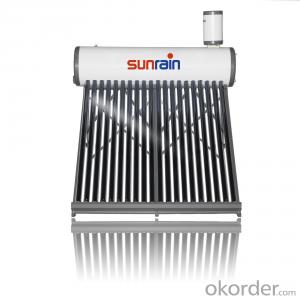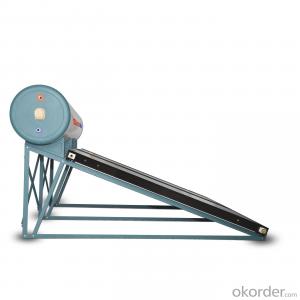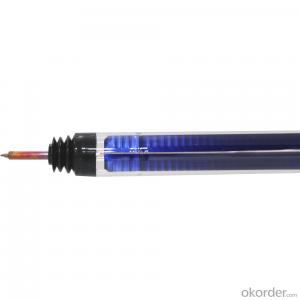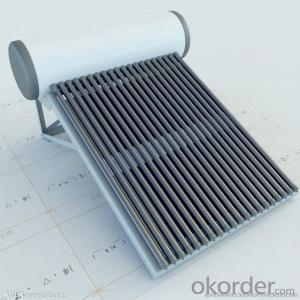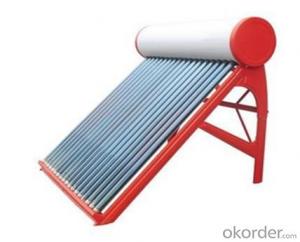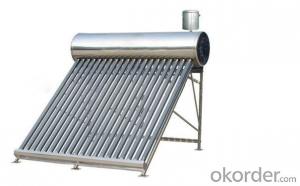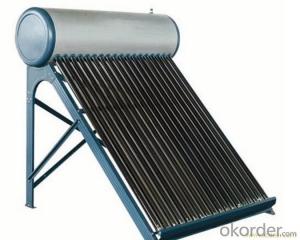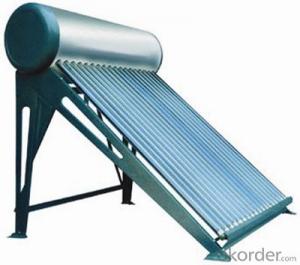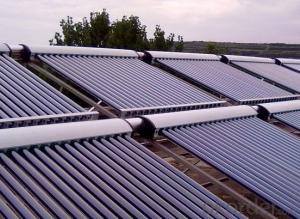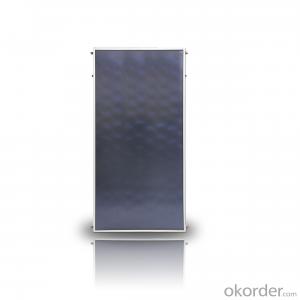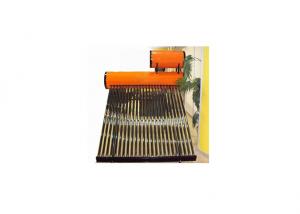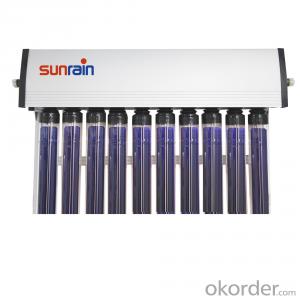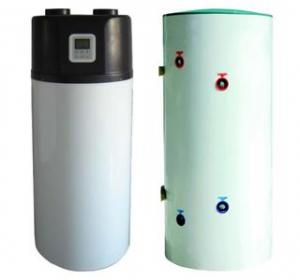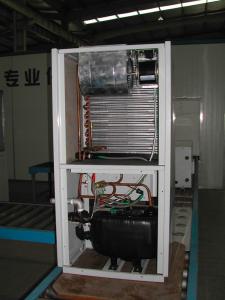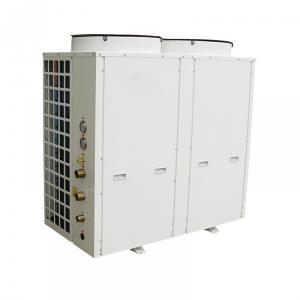150L-200L Solar Water Heater for Livestock - China Famous Brand
- Loading Port:
- China main port
- Payment Terms:
- TT OR LC
- Min Order Qty:
- 10 set
- Supply Capability:
- 10000 set/month
OKorder Service Pledge
OKorder Financial Service
You Might Also Like
Solar water heaters features
1. The upright tank can make the water temperature to a high level. It can hot the water instantly
2. The tank inside the building, the hot water loses less energy than the normal one
3. The solar collector and the tank of solar water heater is separated, that makes the system combine with the building perfectly, which will reduce the sightseeing for the building and environment around
4. Back up with electric heater so that in the day without sunshine hot water can also be used
5. Can be combined with gas or electric heater
6. Max. Pressure: 12bar; Operating Pressure: 6 bar
7. It can be used for other function, such as warming
Solar water heaters working principle
1. The solar collector absorbs solar energy and transmits it to the solar water heater tank through circulation
2. When the temperature of the collector reaches the set value, the controller starts the circulation pump automatically
3. The circulation pump makes heat-conducting liquid circulate automatically
4. The heat-conducting liquid transfers heat to water by lower heat exchanger in the water tank.
5. When the temperature difference between solar collector and heat pipe solar water heaters tank doesn't reach the set value, the circulation pump will be shut automatically
6. In case the temperature of the water tank does not reach Tmax, Electric Heating Element will start to work automatically
Solar water heaters working station component:
1. Operating screen
2. Manometer
3. Pump speed adjust switches
4. Temperature difference circulation pump
5. Flow rate indicator
6. Return circuit connector
7. Safety valve
8. Expansion vessel connector9. Return circuit connector
10. Wall mounting
11. Expansion vessel:8L
12. Pressure resistance: 10 bar pressure for expansion vessel
Solar water heaters specification:
Description | solar water heaters |
Material of out manifold | 0.55mm thickness color steel/ fluorine carbon steel |
Material of inner tank | Food grade 2.0 mm thickness SUS304 stainless steel |
Tank insulating layer | 40mm 45kg/m³ high-density polyurethane foamed |
Inlet and outlet hole | Male G1'' |
Max pressure | 0.6 Mpa |
Solar collector tube | 3.3 Borosilicate glass with N/Al coating |
Thickness of glass tube | 1.6mm |
Vacuum tube tightness | P≤0.005 Pa |
Absorption | as=0.93-0.96 (AM1.5) |
Emission ratio | εh=0.04-0.06 (80C±5C) |
Idle sunning property parameters | Y=220~260m2.C/KW |
Average heat loss coefficient | ULT=0.6~0.7W/(m2.C) |
Bracket: | 2.0mm thickness aluminum alloy |
Tank weight | 75KGS |
Tank size | 560mm Dia x 1810mm Height |
Tank capacity | 300L |
Solar collector | 2pcs 58x1800x15tube solar collector |
Absorber area | 2.811 m² |
Working station | SP116 working station |
Heat exchanger length | Upper:12m, Underside:18m |
Solar water heaters details show:
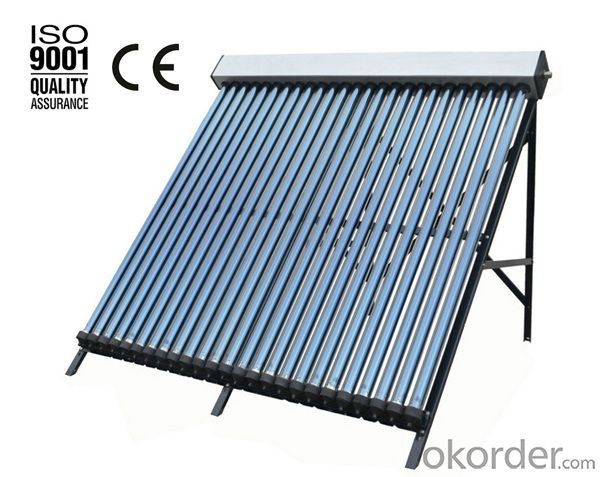
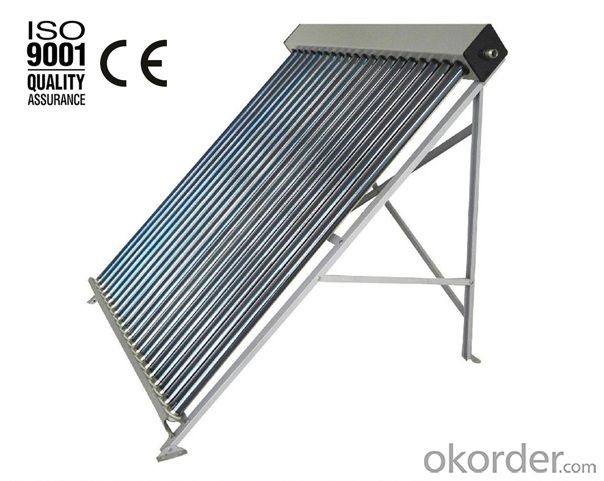
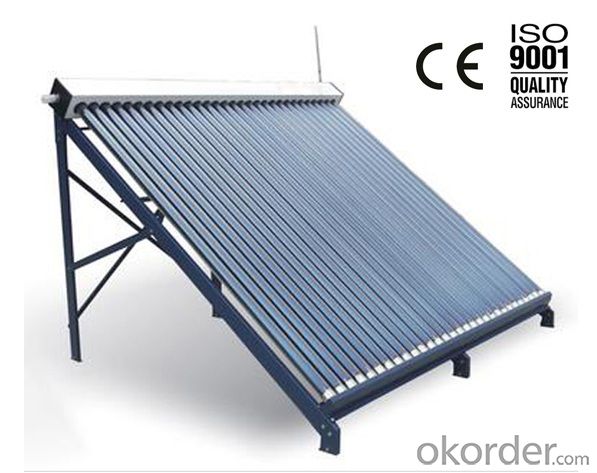
Benefits of this kind of solar water heaters:
1. Prolong the life of your existing water heater
2.Costs less than an electric, gas or oil water heater
3.No maintenance required
4.Lasts longer than a traditional hot water heater
5.Reduce your water heating costs
- Q: Can a solar water heater be used in areas with high levels of air pollution from household sources?
- Areas with high levels of air pollution from household sources can still use solar water heaters. These heaters utilize the sun's energy to heat water and are not affected by the air quality. As long as there is enough sunlight, the solar water heater will work well. However, it should be noted that air pollution can decrease the efficiency of the solar panels by blocking and reducing sunlight. Therefore, it may be necessary to clean and maintain the solar panels regularly in polluted areas for optimal performance.
- Q: What is the quality standard for solar water heaters, to the vast number of consumers a clear standard for reference
- 3 bracket. Support must be able to withstand all kinds of corrosion, or have 3-5 years after stent decay, collapse, the solar energy would be ruined, do not buy that support the paint on the brush, brush to paint on the easy detachment, scaffold exposed part is easy to rot, is not to buy stainless steel bracket. Stainless steel is not easy to rust, but the stainless steel material is soft, the bearing capacity is weak.4 liner, at present, most of the solar water heater manufacturers are said to be stainless steel water tank liner. Stainless steel, but chromium and nickel in stainless steel are very different. Good solar water heater uses stainless steel high chromium nickel, ensure the liner durable, corrosion resistance is strong; the use of low grade stainless steel liner is inferior, basic does not contain nickel, corrosion resistance performance is poor, short service life.
- Q: How does the payback period of a solar water heater compare to a traditional water heating system?
- The payback period of a solar water heater is typically shorter compared to a traditional water heating system. This is because the initial cost of installing a solar water heater may be higher, but the savings on energy bills over time can offset the upfront investment. Additionally, solar water heaters are more energy-efficient and environmentally friendly, leading to long-term cost savings and reduced carbon footprint.
- Q: How does the location of the solar water heater affect its efficiency?
- The efficiency of a solar water heater can be greatly affected by its location. It is ideal to position solar water heaters in areas that receive abundant sunlight throughout the day. By placing the heater in a spot with direct and unobstructed access to sunlight, maximum efficiency can be guaranteed. If the solar water heater is installed in a shaded area or in a location frequently blocked by trees, buildings, or other structures, it will receive less sunlight and, consequently, produce less heat. This can lead to decreased efficiency and lower water temperatures. Furthermore, the efficiency of the solar collector can also be influenced by its orientation and tilt angle. In the northern hemisphere, for instance, it is advisable for the collector to face south in order to maximize sun exposure. The tilt angle should be adjusted to match the latitude of the installation site. An incorrect orientation or tilt angle may result in reduced efficiency as the collector may not receive optimal sunlight. In addition, the climate of the location can impact the efficiency of the solar water heater. Areas with more sunshine and higher average temperatures generally yield better results. Cold climates or regions with frequent cloudy days may experience decreased efficiency as the solar collector may struggle to generate enough heat. To conclude, the location of a solar water heater plays a vital role in its efficiency. Placing it in an area with abundant sunlight, minimal shading, correct orientation, and tilt angle will maximize its performance and ensure optimal water heating capabilities.
- Q: Can a solar water heater be used with a swimming pool?
- Yes, a solar water heater can be used with a swimming pool. Solar water heaters utilize the sun's energy to heat water, and this can be applied to heating the water in a swimming pool as well. By installing a solar water heating system specifically designed for swimming pools, the water can be efficiently heated using renewable solar energy.
- Q: Can a solar water heater be used in areas with wildlife or pest issues?
- Yes, a solar water heater can be used in areas with wildlife or pest issues. However, it is important to take precautions to protect the system from potential damage caused by animals. This can be done by installing proper fencing or barriers, using animal deterrent devices, or regularly inspecting and maintaining the system to ensure it remains safe and functional.
- Q: What are the common maintenance issues with a solar water heater?
- Some common maintenance issues with a solar water heater include scaling and mineral buildup on the heating elements, leaking or damaged pipes or valves, malfunctioning temperature or pressure sensors, and issues with the circulation pump or controls. Regular maintenance tasks such as inspecting and cleaning the collectors, checking the fluid levels, and ensuring proper insulation are also important to ensure optimal performance and longevity of the system.
- Q: Are solar water heaters noisy?
- No, solar water heaters are not noisy. They operate silently as they do not require any mechanical parts or motors to function.
- Q: Can a solar water heater be integrated with other renewable energy systems?
- Certainly! A solar water heater has the potential to be combined with various other renewable energy systems. This integration offers a comprehensive and efficient method of addressing the energy requirements of a building or household. For instance, by linking a solar water heater to a solar photovoltaic (PV) system, the generated electricity can be used to power the water heater's pump or auxiliary systems. Consequently, any excess electricity produced by the PV system can be employed to heat water, thereby reducing the reliance on conventional grid electricity. Moreover, a solar water heater can also be integrated with other renewable energy sources like wind or geothermal. In regions abundant with wind energy, it is possible to connect a wind turbine to the same grid as the solar water heater. This allows for the utilization of wind power to supplement solar energy in heating water. Similarly, in areas with access to geothermal resources, a geothermal heat pump can be used in conjunction with the solar water heater to provide efficient heating and cooling for the water. The integration of diverse renewable energy systems provides a sustainable and resilient energy solution. By harnessing multiple sources of renewable energy, the overall energy generation and consumption can be optimized, thereby reducing dependence on fossil fuels and minimizing environmental impact. Additionally, the combination of different renewable energy technologies ensures a more reliable and consistent energy supply, as the availability of one resource can compensate for the variability of another. In conclusion, integrating a solar water heater with other renewable energy systems is a viable and advantageous approach to maximizing energy efficiency and sustainability. This approach allows for the utilization of multiple renewable resources, reduces reliance on traditional energy sources, and contributes to a greener and more resilient energy future.
- Q: How does the water quality of a solar water heater compare to a traditional water heating system?
- The water quality of a solar water heater is generally comparable to that of a traditional water heating system. Both systems use the same water supply, and the quality of the water depends on the source and any treatment methods applied. However, solar water heaters may have an advantage in areas with hard water as they can help reduce mineral buildup due to the absence of a storage tank.
Send your message to us
150L-200L Solar Water Heater for Livestock - China Famous Brand
- Loading Port:
- China main port
- Payment Terms:
- TT OR LC
- Min Order Qty:
- 10 set
- Supply Capability:
- 10000 set/month
OKorder Service Pledge
OKorder Financial Service
Similar products
Hot products
Hot Searches
Related keywords
